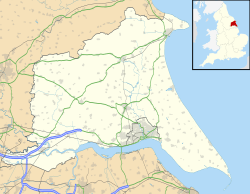Wetwang Slack facts for kids
| Location | near Wetwang, East Riding of Yorkshire |
|---|---|
| Region | Yorkshire |
| Coordinates | 54°01′11″N 0°34′28″W / 54.0198°N 0.5745°W |
| Type | Iron Age Cemetery |
| History | |
| Cultures | Arras Culture |
Wetwang Slack is an amazing ancient site in East Riding of Yorkshire, England. It's from the British Iron Age, a time long ago when people used iron tools. This place is special because it shows us about the Arras culture and their unique way of burying people with chariots!
Archaeologists, who are like history detectives, explored Wetwang Slack in 2001 and 2002. They found some incredible things there.
The site is in a dry valley near the village of Wetwang. The most exciting finds were three chariot burials. These are graves where people were buried with parts of a cart or chariot. All the bodies were laid out facing north. Many of the cool items found here are now kept safe at the British Museum.
Contents
Discovering Ancient Burials
Archaeologists found three main burials at Wetwang Slack. Each one tells us a bit more about the people who lived during the Iron Age.
Burial 1: A Young Man's Grave
This grave was inside a triangular area with ditches. Sadly, some parts of the ditches were removed by machines. Inside, archaeologists found the bones of a young man. He was lying on his right side with his knees pulled up.
- Special Items: They found pig bones placed on top of his body. This might have been a food offering.
- Chariot Parts: The iron rings from the wheels and the hubs were still there. Some spokes from the wheels also survived. The chariot's axle was about 1.81 meters long.
Burial 2: A Young Woman's Grave
The second burial was found inside a square area, like a square mound, about 9.6 meters wide. In the middle of this mound were the bones of a young woman. She was facing right with her legs bent.
- Special Items: Just like in Burial 1, pig bones were placed on her skeleton.
- Chariot Parts: The complete chariot was taken apart and placed under her. It even had its long pole, where horses would have been attached.
- Other Finds: They found iron wheel rings and bronze hubs. There were also four spokes and special rings called terret rings, which were used to guide the reins.
- Personal Items: Behind her head, they discovered two horse-bits, a bronze case with a chain, a pin, and a shiny bronze mirror!
Burial 3: Another Young Person's Grave
Some parts of this burial were damaged by quarrying, which is when people dig up stone. The top part of the skull was missing. This body was also placed on top of a dismantled chariot. It belonged to a young person.
- Body Position: The person was facing right with their thighs bent at right angles.
- Chariot Parts: Iron wheel rings and hubs were found, along with other chariot pieces. The axle was about 1.83 meters long.
- Warrior's Gear: An iron sword in its scabbard (a case for the sword) was found lying across the body. It had cool bronze decorations.
- Jewelry: Two rings with bright red coral in the middle were also found. These might have been part of the sword belt. Coral was a popular material for jewelry during the Arras culture, even seen in items from the famous Queen's Barrow at Arras.


